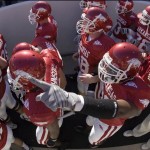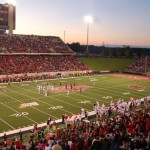Fox Sports 1, the cable television network that’s hoping to challenge ESPN for a large piece of the sports advertising pie, launched last Saturday.
It should come as no surprise that a key component of the new network’s program schedule is a weekday program called “Fox Football Daily.” The program will be carried 12 months a year, not just during football season. Fox college announcers such as Charles Davis, Gus Johnson, Erin Andrews and Petros Papadakis will be regulars on the show.
It also should come as no surprise that “Fox Football Daily” won’t just concentrate on the NFL. College football will be an important part of the mix. College football, you see, has never been bigger on television than it is right now. With so many games on TV, the question is this: “Where’s the ceiling?”
“Television has become a major catalyst for intercollegiate athletics, especially in the Southeastern Conference,” says University of Arkansas athletic director Jeff Long. “The revenues we receive through the television agreements in the SEC are a major source of support for our program and our entire university. As the SEC Network comes aboard in 2014, it will be a tremendous opportunity for our program and our university to tell our story throughout the nation.”
Back in May, it was announced that the SEC and ESPN had signed an agreement running through 2034 to create and operate a cable network that will launch next August. The network and its digital platforms will air more than 1,000 events a year, including 45 SEC football games and more than 100 basketball games. There will be studio shows, original content, spring football games, signing day coverage and much more.
“The increased exposure will require that we spend even more time on the presentation of our program and university,” Long says. “It will also provide us with the financial resources to support our more than 460 student-athletes and build for the future of our program.”
The rich get richer.
Brad Teague, the athletic director at the University of Central Arkansas in Conway, understands.
“What are known as the Big Five conferences – the SEC, Big Ten, Pac-12, Big 12 and ACC – are pushing to form their own subdivision so they can have a few rules which are different from the rest of us in Division I,” Teague says. “The main rule they want is the ability to pay their student-athletes a stipend of $5,000 to $7,500 a year. My opinion is to let them run with this.
“They do need their own rules because the athletic budgets for those of us at the FCS level of Division I are about 15 percent the size of the budgets for Big Five Conference schools. Even the schools in the other five FBS conferences have budgets half the size or less of the schools in the Big Five conferences. Give them the ability to pay, but continue to let the rest of us play them and participate in a national playoff system. Everyone is happy then.”
The television money paid to FBS schools is staggering. There are rights agreements in place worth more than $10 billion. Advertisers now spend almost $1.2 billion each season on college football telecasts.
No one doubts that college football on television now helps steer the entire athletic ship at the major college level.
“Coaches want to stay employed and win games,” Jerry Fowler wrote for CBSSports.com. “Athletic directors and presidents want to grow the program and revenues while sustaining collegiate principles. Television execs want good games, ratings and exposure for both parties. Commissioners must throw all the elements in a blender and hope it doesn’t taste like wheat grass.”
Back in October 2011, Gene Defilippo, the now former Boston College athletic director, may have been a bit too honest for his own good when, after the ACC announced it was adding Pitt and Syracuse, he said: “TV – ESPN – is the one who told us what to do.”
Each FBS conference has a television consultant who helps negotiate on the conference’s behalf. The SEC uses Chuck Gerber of Los Angeles. Presumably because television would like more conference games, the SEC has discussed playing nine rather than eight conference football games each season.
“Anything can happen when television starts telling you what to do,” says Steve Spurrier, the South Carolina head coach.
Terry Mohajir, the Arkansas State University athletic director, states flatly: “Television money is the thing that has transformed our industry. All the revenue models have changed.”
The FBS schools such as ASU that aren’t in the Big Five conferences often are required to play weeknight games for television. ASU, for instance, will host Troy on a Thursday night (Sept. 12) in a game televised by ESPNU and will host Louisiana-Lafayette on a Tuesday night (Oct. 22) in a game telecast by ESPN2. Not many years ago, a Tuesday night college football game would have been unheard of.
Here’s what the television rating agency Nielsen reports on college football:
- Seven college sports telecasts drew more than 12 million viewers from March 2012 until January 2013. Five of those telecasts were football games.
- The BCS national championship game drew 26.38 million viewers, far more than any other college sports event.
- The 28 telecasts involving the 12 SEC members who have been in the conference the longest drew an average of 3.957 million viewers (that excludes the SEC championship game). The nine SEC broadcasts involving Missouri and Texas A&M drew an average of 3.926 million viewers.
- As recently as 2004, the four major networks – Fox, ABC, NBC and CBS – combined to telecast four Saturday night college football games in prime time. Last year, those four networks had 29 Saturday night games drawing more than 110 million viewers.
- While sports accounts for just 1.3 percent of television programming, 41 percent of TV-related Tweets relate to live sporting events.
- The only televised sports properties that consistently outrank college football are the NFL and the Summer Olympics.
In an era when viewers tape so many television programs and skip the ads, live sports events are considered DVR-proof. Nielsen reported that 99 percent – that’s right, 99 percent – of Americans between the ages of 18 and 49 watched sports live or within the same day it was aired at some point during the survey period. That’s more than news (96 percent), sitcoms (75 percent) and drama (70 percent).
AT&T spent $342.8 million during the survey period in advertising on sports events. Bud Light was second at $213.3 million. Of the total spent by AT&T on sports, $43.7 million was spent on college football. Ford spent $18.9 million on college football. The rest of the top five college football spenders were Home Depot at $17.4 million, Verizon Wireless at $16.6 million and Capital One at $15.1 million.
The $1.163 billion spent last season by advertisers on college football telecasts was up from $850 million in 2011 and $970 million in 2012.
Consider how far we’ve come since the first game was telecast between Fordham and Waynesburg in September 1939 when television was in the experimental stage. Very few games were broadcast nationally each week through the 1970s. Essentially, there was one big game a week on ABC. In 1981, Oklahoma and Georgia filed suit against the NCAA, alleging antitrust violations.
The floodgate had opened.
On June 27, 1984, the U.S. Supreme Court ruled that the NCAA television plan violated the Sherman Antitrust Act. Suddenly, individual schools and athletic conferences were free to negotiate contracts. By 1985, there were almost 200 games on television.
This year, that number will be far, far higher.
ABC, which has been airing college football since 1966, will again have Saturday night games each week, which it has done since 2006. The network, whose sports division was absorbed by ESPN, also will have regional games on Saturday afternoons.
NBC again will carry all Notre Dame home games and the annual Bayou Classic between Grambling and Southern University.
CBS has carried SEC games since 1996. The network also telecasts the Army-Navy game each season and the Navy-Notre Dame game when Navy is the home team.
Fox will again air weekly games from the Big 10 and the Pac-12 each week along with the Big 10 championship game, the Pac-12 championship game and the Cotton Bowl.
Conferences, meanwhile, operate regional television networks that air games on local stations.
And then there’s cable. TBS became the first cable station to offer nationally televised college football games in 1982. ESPN followed with the Independence Bowl in December 1982. That was ESPN’s first live college football game.
ESPN2 began broadcasting live games in 1994, and ESPNU got in on the act in 2005.
Fox has its regional networks and now Fox Sports 1. What began as College Sports Television is now the CBS Sports Network, and what once was Versus is now the NBC Sports Network.
Don’t forget the Big Ten Network, Comcast/Charter Sports Southeast, the Pac-12 Network and the Longhorn Network.
Again, the question must be asked: “Where’s the ceiling?”
“There is no ceiling,” Arkansas State’s Mohajir says. “This isn’t something that’s going to subside anytime soon. Schools are building brands now. Nebraska, for example, is more than a university. It’s a great brand. As long as there are teams willing to play the games on the nights that the television networks want the games played, we’ll see even more games on national television and more money spent on rights fees. It’s all part of building your brand.”













